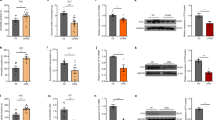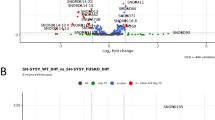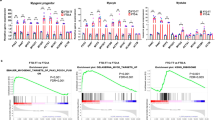Abstract
A block of single-nucleotide polymorphisms within intron 1 of the FTO (fat mass and obesity associated) gene is associated with variation in body weight. Previous works suggest that increased expression of FTO, which encodes a 2-oxoglutarate-dependent nucleic acid demethylase, leads to increased body weight, although the underlying mechanism has remained unclear. To elucidate the function of FTO, we examined the consequences of altered FTO levels in cultured cells and murine brain. Here we show that a knockdown of FTO in HEK293 cells affects the transcripts levels of genes involved in the response to starvation, whereas overexpression of FTO affects the transcript levels of genes related to RNA processing and metabolism. Subcellular localization of FTO further strengthens the latter notion. Using immunocytochemistry and confocal laser scanning microscopy, we detected FTO in nuclear speckles and – to a lesser and varying extent – in the nucleoplasm and nucleoli of HEK293, HeLa and MCF-7 cells. Moreover, RNA modification analyses revealed that loss of Fto affects the 3-methyluridine/uridine and pseudouridine/uridine ratios in total brain RNA. We conclude that altered levels of FTO have multiple and diverse consequences on RNA modifications and the transcriptome.
Similar content being viewed by others
Log in or create a free account to read this content
Gain free access to this article, as well as selected content from this journal and more on nature.com
or
References
Dina C, Meyre D, Gallina S et al. Variation in FTO contributes to childhood obesity and severe adult obesity. Nat Genet 2007; 39: 724–726.
Frayling TM, Timpson NJ, Weedon MN et al. A common variant in the FTO gene is associated with body mass index and predisposes to childhood and adult obesity. Science 2007; 316: 889–894.
Scuteri A, Sanna S, Chen WM et al. Genome-wide association scan shows genetic variants in the FTO gene are associated with obesity-related traits. PLoS Genet 2007; 3: e115.
Stratigopoulos G, LeDuc CA, Cremona ML et al. Cut-like homeobox 1 (CUX1) regulates expression of the fat mass and obesity-associated and retinitis pigmentosa GTPase regulator-interacting protein-1-like (RPGRIP1L) genes and coordinates leptin receptor signaling. J Biol Chem 2011; 286: 2155–2170.
Berulava T, Horsthemke B : The obesity-associated SNPs in intron 1 of the FTO gene affect primary transcript levels. Eur J Hum Genet 2010; 18: 1054–1056.
Boissel S, Reish O, Proulx K et al. Loss-of-function mutation in the dioxygenase-encoding FTO gene causes severe growth retardation and multiple malformations. Am J Hum Genet 2009; 85: 106–111.
van den Berg L, de Waal HD, Han JC et al. Investigation of a patient with a partial trisomy 16q including the fat mass and obesity associated gene (FTO): fine mapping and FTO gene expression study. Am J Med Genet A 2010; 152A: 630–637.
Fischer J, Koch L, Emmerling C et al. Inactivation of the Fto gene protects from obesity. Nature 2009; 458: 894–898.
Church C, Lee S, Bagg EA et al. A mouse model for the metabolic effects of the human fat mass and obesity associated FTO gene. PLoS Genet 2009; 5: e1000599.
Church C, Moir L, McMurray F et al. Overexpression of Fto leads to increased food intake and results in obesity. Nat Genet 2010; 42: 1086–1092.
Robbens S, Rouze P, Cock JM et al. The FTO gene, implicated in human obesity, is found only in vertebrates and marine algae. J Mol Evol 2008; 66: 80–84.
Gerken T, Girard CA, Tung YC et al. The obesity-associated FTO gene encodes a 2-oxoglutarate-dependent nucleic acid demethylase. Science 2007; 318: 1469–1472.
Jia G, Yang CG, Yang S et al. Oxidative demethylation of 3-methylthymine and 3-methyluracil in single-stranded DNA and RNA by mouse and human FTO. FEBS Lett 2008; 582: 3313–3319.
Han Z, Niu T, Chang J et al. Crystal structure of the FTO protein reveals basis for its substrate specificity. Nature 2010; 464: 1205–1209.
Jia G, Fu Y, Zhao X et al. N6-methyladenosine in nuclear RNA is a major substrate of the obesity-associated FTO. Nat Chem Biol 2011; 7: 885–887.
Dominissini D, Moshitch-Moshkovitz S, Schwartz S et al. Topology of the human and mouse m6A RNA methylomes revealed by m6A-seq. Nature 2012; 485: 201–206.
Meyer Kate D, Saletore Y, Zumbo P et al. Comprehensive analysis of mRNA methylation reveals enrichment in 32 UTRs and near stop codons. Cell 2012; 149: 1635–1646.
Wu Q, Saunders RA, Szkudlarek-Mikho M et al. The obesity-associated Fto gene is a transcriptional coactivator. Biochem Biophys Res Commun 2010; 401: 390–395.
Crain PF : Preparation and enzymatic hydrolysis of DNA and RNA for mass spectrometry. Methods Enzymol 1990; 193: 782–790.
Wawrzik M, Unmehopa UA, Swaab DF et al. The C15orf2 gene in the Prader-Willi syndrome region is subject to genomic imprinting and positive selection. Neurogenetics 2010; 11: 153–161.
Neumann LC, Markaki Y, Mladenov E et al. The imprinted NPAP1/C15orf2 gene in the Prader–Willi syndrome region encodes a nuclear pore complex associated protein. Hum Mol Genet 2012, ; e-pub ahead of print 3 July 2012; doi:10.1093/hmg/dds228.
Zhou J, Liang B, Li H : Functional and structural impact of target uridine substitutions on the H/ACA ribonucleoprotein particle pseudouridine synthase. Biochemistry 2010; 49: 6276–6281.
Cheung MK, Gulati P, O'Rahilly S et al. FTO expression is regulated by availability of essential amino acids. Int J Obes 2012, ; e-pub ahead of print 22 May 2012; doi: 10.1038/ijo.2012.77.
Kaushik S, Rodriguez-Navarro JA, Arias E et al. Autophagy in hypothalamic AgRP neurons regulates food intake and energy balance. Cell Metab 2011; 14: 173–183.
Rabinowitz JD, White E : Autophagy and metabolism. Science 2010; 330: 1344–1348.
Zhang Y, Goldman S, Baerga R et al. Adipose-specific deletion of autophagy-related gene 7 (atg7) in mice reveals a role in adipogenesis. Proc Natl Acad Sci USA 2009; 106: 19860–19865.
Huber TB, Walz G, Kuehn EW : mTOR and rapamycin in the kidney: signaling and therapeutic implications beyond immunosuppression. Kidney Int 2011; 79: 502–511.
Spector DL, Lamond AI : Nuclear speckles. Cold Spring Harb Perspect Biol 2011; 3: a000646.
Tripathi V, Ellis JD, Shen Z et al. The nuclear-retained noncoding RNA MALAT1 regulates alternative splicing by modulating SR splicing factor phosphorylation. Mol Cell 2010; 39: 925–938.
Jack K, Bellodi C, Landry DM et al. rRNA pseudouridylation defects affect ribosomal ligand binding and translational fidelity from yeast to human cells. Mol Cell 2011; 44: 660–666.
Estornell E, Cabo J, Barber T : Protein synthesis is stimulated in nutritionally obese rats. J Nutr 1995; 125: 1309–1315.
Wu G, Xiao M, Yang C et al. U2 snRNA is inducibly pseudouridylated at novel sites by Pus7p and snR81 RNP. EMBO J 2011; 30: 79–89.
Acknowledgements
We thank Professor G Iliakis for providing access to the confocal laser microscope and Professor M Linscheid for providing equipment and helpful suggestions. We are grateful to one of the anonymous reviewers for pointing out the genes related to ciliary function. We are thankful to Christian Grosser for sharing his data. This work was supported by the Bundesministerium für Bildung und Forschung (NGFN plus 01GS0820) and Deutsche Forschungsgemeinschaft (LI309/19-1, LI309/30-2).
Accession code: Miccroarray data generated by hybridization of RNA from both FTO1_C1 and FTO2_D4 clones with and without induced expression as well as from FTO siRNA- and scrampled siRNA-treansfected cells can be obtained from Gene Expression Omnibus (GSE33870). URL: GeneTrail gene set analysis tool at http://genetrail.bioinf.uni-sb.de/).
Author information
Authors and Affiliations
Corresponding author
Ethics declarations
Competing interests
The authors declare no conflict of interest.
Additional information
Supplementary Information accompanies the paper on European Journal of Human Genetics website
Supplementary information
Rights and permissions
About this article
Cite this article
Berulava, T., Ziehe, M., Klein-Hitpass, L. et al. FTO levels affect RNA modification and the transcriptome. Eur J Hum Genet 21, 317–323 (2013). https://doi.org/10.1038/ejhg.2012.168
Received:
Revised:
Accepted:
Published:
Issue date:
DOI: https://doi.org/10.1038/ejhg.2012.168
Keywords
This article is cited by
-
Long-term exercise training down-regulates m6A RNA demethylase FTO expression in the hippocampus and hypothalamus: an effective intervention for epigenetic modification
BMC Neuroscience (2022)
-
The impact of probiotic supplementation during pregnancy on DNA methylation of obesity-related genes in mothers and their children
European Journal of Nutrition (2019)
-
Binding of clenbuterol to HSA and FTO: a spectroscopic analysis and molecular docking
Medicinal Chemistry Research (2018)
-
Polygene Varianten und Epigenetik bei Adipositas
Medizinische Genetik (2017)
-
Investigation of the interaction between FTO and 3-substituted 2-aminochromones by spectroscopy and molecular modeling
Medicinal Chemistry Research (2017)



